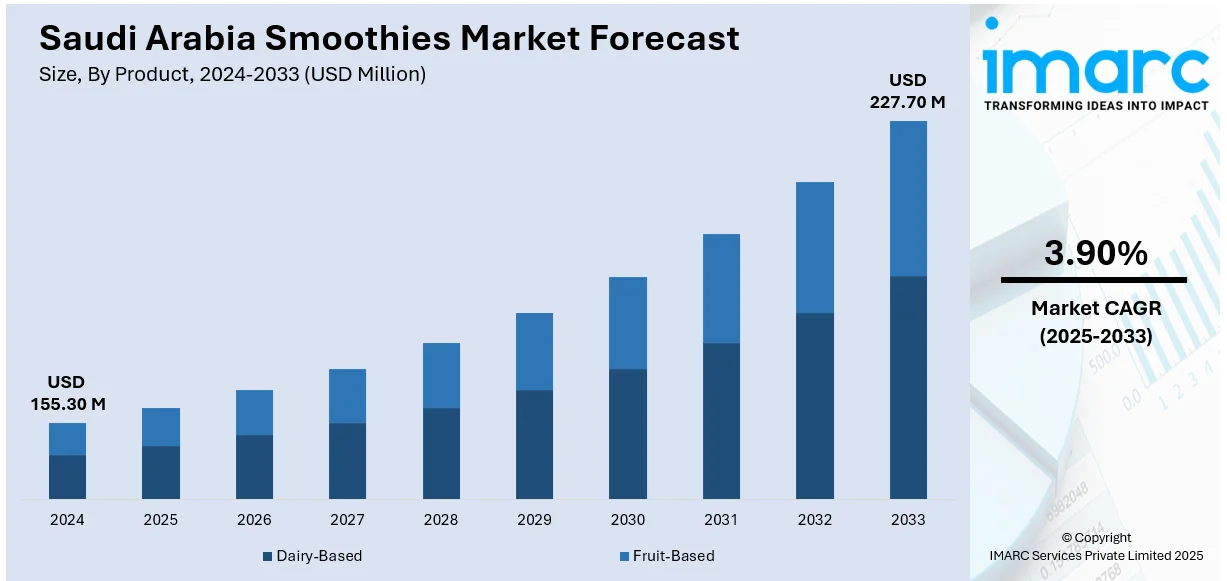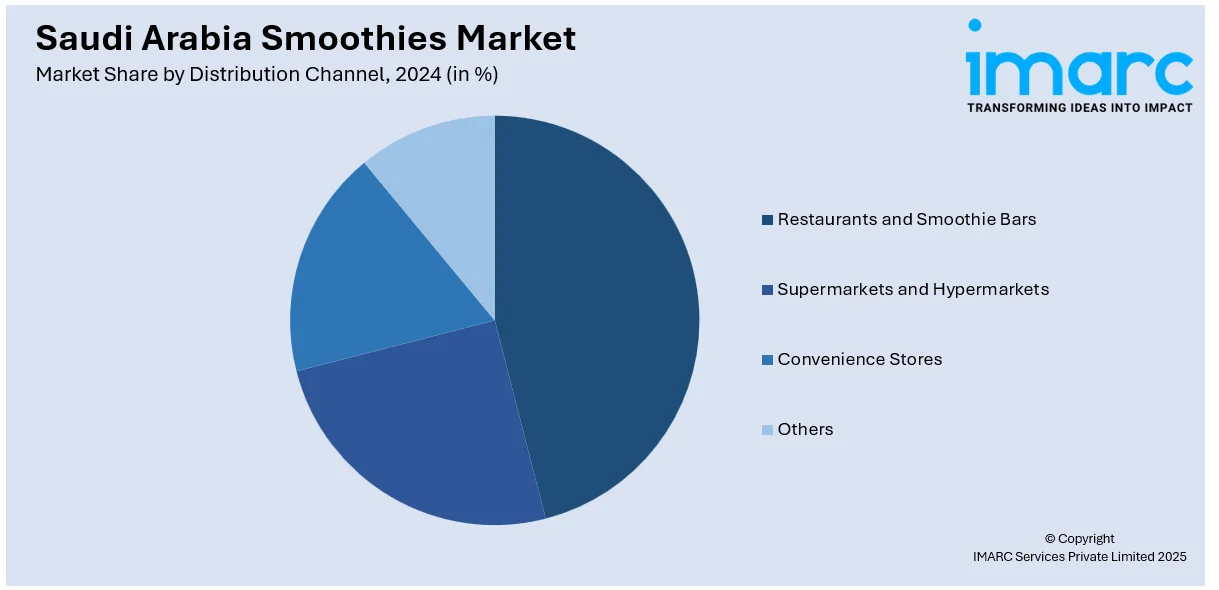
Saudi Arabia Smoothies Market Size, Share, Trends and Forecast by Product, Distribution Channel, Packaging Material, Consumption Pattern, and Region, 2025-2033
Saudi Arabia Smoothies Market Overview:
The Saudi Arabia smoothies market size reached USD 155.30 Million in 2024. Looking forward, IMARC Group expects the market to reach USD 227.70 Million by 2033, exhibiting a growth rate (CAGR) of 3.90% during 2025-2033. The market is driven by rising health awareness, a young population embracing fitness trends, government support for local agriculture under Vision 2030, and elevating demand for natural and functional beverages that align with cultural preferences, such as date-based ingredients, offering both nutritional value and sustainability.
|
Report Attribute
|
Key Statistics
|
|---|---|
|
Base Year
|
2024 |
|
Forecast Years
|
2025-2033
|
|
Historical Years
|
2019-2024
|
| Market Size in 2024 | USD 155.30 Million |
| Market Forecast in 2033 | USD 227.70 Million |
| Market Growth Rate 2025-2033 | 3.90% |
Saudi Arabia Smoothies Market Trends:
Rising Health Consciousness and Lifestyle Shifts Among Young Consumers
One of the key drivers of the Saudi Arabian smoothies market is the increasing health awareness among the population, especially the youth and urban middle-class segments. The Kingdom has seen a discernible change in eating habits in recent years, with rising awareness of the risks involved in consuming processed foods, sugary drinks, and fast food items. Moreover, the increasing incidences of obesity and lifestyle diseases, such as type-2 diabetes and hypertension, are encouraging individuals and health authorities to promote healthier alternatives, such as smoothies. This trend is especially pertinent among younger consumers, such as millennials and Gen Z, who are not only more informed but also more active on social media platforms that encourage wellness trends, fitness routines, and clean eating. Smoothies are seen by many of these consumers as a convenient and speedy means of consuming necessary nutrients without sacrificing flavor. The growing popularity of gym memberships, exercise apps, and wellness influencers also contributes to the growing consumption of smoothies as part of an overall lifestyle change.

Government Initiatives Supporting the Food and Beverage Sector
Another driver is the top-down strategy of national policy and strategic government initiatives. In Saudi Arabia's Vision 2030, the government has made diversification of its economy away from oil a priority, with focus on establishing the non-oil sectors, including food and beverage (F&B). As a part of this strategy, heavy investments have been made in local food processing infrastructure, agriculture, and supply chain modernization. This has a direct impact on the smoothies market by making fruits, vegetables, and dairy—key ingredients for smoothie manufacturing—more accessible and affordable. Government incentives have also motivated SMEs and startups to innovate in the F&B industry, driving the development of health-oriented product lines such as cold-pressed juices, ready-to-drink smoothies, and organic drinks. The Kingdom is also actively pursuing reducing its food imports by promoting domestic production of high-value crops, such as bananas, dates, and berries, through innovative agricultural methods like hydroponics and controlled-environment agriculture.
Saudi Arabia Smoothies Market Segmentation:
IMARC Group provides an analysis of the key trends in each segment of the market, along with forecasts at the region/country level for 2025-2033. Our report has categorized the market based on product, distribution channel, packaging material, and consumption pattern.
Product Insights:
- Dairy-Based
- Fruit-Based
The report has provided a detailed breakup and analysis of the market based on the product. This includes dairy-based and fruit-based.
Distribution Channel Insights:

- Restaurants and Smoothie Bars
- Supermarkets and Hypermarkets
- Convenience Stores
- Others
A detailed breakup and analysis of the market based on the distribution channel have also been provided in the report. This includes restaurants and smoothie bars, supermarkets and hypermarkets, convenience stores, and others.
Packaging Material Insights:
- Plastic
- Paper
- Glass
- Others
The report has provided a detailed breakup and analysis of the market based on the packaging material. This includes plastic, paper, glass, and others.
Consumption Pattern Insights:
- Out of Home
- At Home
A detailed breakup and analysis of the market based on the consumption pattern have also been provided in the report. This includes out of home and at home.
Regional Insights:
- Northern and Central Region
- Western Region
- Eastern Region
- Southern Region
The report has also provided a comprehensive analysis of all the major regional markets, which include Northern and Central Region, Western Region, Eastern Region, and Southern Region.
Competitive Landscape:
The market research report has also provided a comprehensive analysis of the competitive landscape. Competitive analysis such as market structure, key player positioning, top winning strategies, competitive dashboard, and company evaluation quadrant has been covered in the report. Also, detailed profiles of all major companies have been provided.
Saudi Arabia Smoothies Market News:
- December 2024: Saudi Arabia introduced Milaf Cola, reportedly the world's first date-based soft drink, at the Riyadh Date Festival. Developed by Thurath Al-Madina, a subsidiary of the Public Investment Fund, this beverage utilized locally sourced dates, offering a healthier alternative to traditional sodas with no added sugar.
- May 2024: Feels Smoothie & Juice Bar, originally from Dubai, opened its first Saudi Arabian branch in Riyadh with the aid of an influencer marketing campaign by Starfish Agency. The menu offered a variety of health-focused items, including smoothies, acai bowls, and vegan milkshakes.
Saudi Arabia Smoothies Market Report Coverage:
| Report Features | Details |
|---|---|
| Base Year of the Analysis | 2024 |
| Historical Period | 2019-2024 |
| Forecast Period | 2025-2033 |
| Units | Million USD |
| Scope of the Report |
Exploration of Historical Trends and Market Outlook, Industry Catalysts and Challenges, Segment-Wise Historical and Future Market Assessment:
|
| Products Covered | Dairy-Based, Fruit-Based |
| Distribution Channels Covered | Restaurants and Smoothie Bars, Supermarkets and Hypermarkets, Convenience Stores, Others |
| Packaging Materials Covered | Plastic, Plastic, Glass, Others |
| Consumption Patterns Covered | Out of Home, At Home |
| Regions Covered | North India, South India, East India, West India |
| Customization Scope | 10% Free Customization |
| Post-Sale Analyst Support | 10-12 Weeks |
| Delivery Format | PDF and Excel through Email (We can also provide the editable version of the report in PPT/Word format on special request) |
Key Questions Answered in This Report:
- How has the Saudi Arabia smoothies market performed so far and how will it perform in the coming years?
- What is the breakup of the Saudi Arabia smoothies market on the basis of product?
- What is the breakup of the Saudi Arabia smoothies market on the basis of distribution channel?
- What is the breakup of the Saudi Arabia smoothies market on the basis of packaging material?
- What is the breakup of the Saudi Arabia smoothies market on the basis of consumption pattern?
- What are the various stages in the value chain of the Saudi Arabia smoothies market?
- What are the key driving factors and challenges in the Saudi Arabia smoothies market?
- What is the structure of the Saudi Arabia smoothies market and who are the key players?
- What is the degree of competition in the Saudi Arabia smoothies market?
Key Benefits for Stakeholders:
- IMARC’s industry report offers a comprehensive quantitative analysis of various market segments, historical and current market trends, market forecasts, and dynamics of the Saudi Arabia smoothies market from 2019-2033.
- The research report provides the latest information on the market drivers, challenges, and opportunities in the Saudi Arabia smoothies market.
- Porter's five forces analysis assist stakeholders in assessing the impact of new entrants, competitive rivalry, supplier power, buyer power, and the threat of substitution. It helps stakeholders to analyze the level of competition within the Saudi Arabia smoothies industry and its attractiveness.
- Competitive landscape allows stakeholders to understand their competitive environment and provides an insight into the current positions of key players in the market.
Need more help?
- Speak to our experienced analysts for insights on the current market scenarios.
- Include additional segments and countries to customize the report as per your requirement.
- Gain an unparalleled competitive advantage in your domain by understanding how to utilize the report and positively impacting your operations and revenue.
- For further assistance, please connect with our analysts.
 Request Customization
Request Customization
 Speak to an Analyst
Speak to an Analyst
 Request Brochure
Request Brochure
 Inquire Before Buying
Inquire Before Buying




.webp)




.webp)












